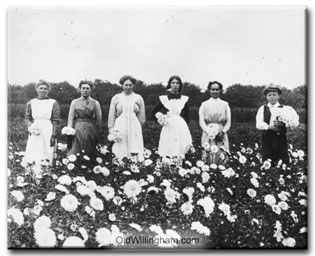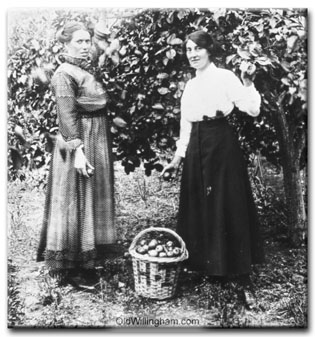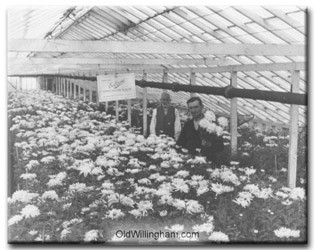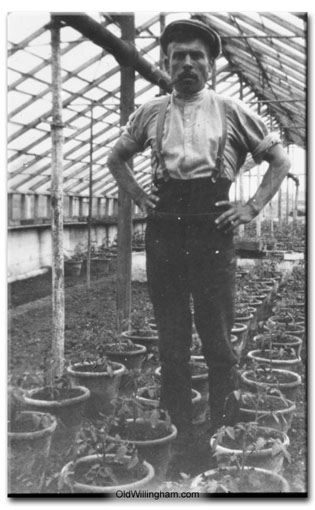|
||||||
|
|
||||||
|
Reprint from The Gardeners’ Chronicle May the 19th.
1894. Willingham Local History Reprints The Fruit & Flower Industries in Cambridgeshire, Willingham.
Among the first is the large area devoted to the cultivation of fruit,
and the healthy and fruitful condition of most of the fruit-gardens and
orchards - not by any means that all are equally prosperous and perfect.
But the average alike of cultivation and produce is, perhaps, as high, or
even higher in Willingham than any other district of Cambs, not even
excepting such as Cottenham, Meldreth and Melbourn, the latter two called
the home of the Gage especially.
Without disparaging the efforts of others who entered heartily into the good work of fruit-growing at Willingham, these would be the first to admit that the late Mr. I. F. Thoday, who died about ten years since, was the great leader and pioneer in this matter of growing of fruit and Asparagus in this parish. He was so far satisfied with the results of his investments of skill and capital in those directions, that before his death he seems to have had visions of Willingham sweeping over the parish, and even making tracks to Long Stanton with fruit gardens and orchards, with a jam factory hugging the station to convert its perishable produce into unperishable commodities to be disposed of at leisure at the best profits. Perhaps the highest testimony that could be given to the soundness of the father’s judgement will be found in the simple statement of the significant fact that two of his sons and Mrs. Thoday are still among the largest, and most successful fruit growers in the parish. The eldest son Mr. I. F. Thoday, Esq., of the Vineries, Willingham, has just added to his area under Gage-plums and other fruits, planting as a ground crop the two Raspberries, Semper Fidelis, and Baumforth’s Seedling - the latter, without doubt , the finest of all Raspberries. With the skilful assistance of Mr. Grant, his able manager, the most rigid selection of a few of the best varieties for the site, soil, and markets, liberal culture, and the most scrupulous cleanliness, success both outside and indoors has been achieved. For example, while a few others were being tried, the following were the main crops growing over the acres: -
High culture is visible everywhere, in deep cultivation, careful manuring, and the early and constant suppression of weeds. The suppression of maggots, red-spider and caterpillars is begun very early, and continued until no living pests can be found. Owing to the intensity of the drought last year chiefly, red-spider were alive, and hopping about on the bushes this year in January; the common caterpillar and another boring grub or maggot were busy on the bushes in the middle of April, at the time of my last visit, and Mr. Grant was prepared with his third dressing to finish off the stragglers, the main crop being already killed. The fruit trees and bushes were crowded with fruit, and before the end of April the first picking of green Gooseberries was picked. Troublesome and costly as are these successive dressings, and they are costly, though Mr. Grant’s cost only about 2s. 6d. an acre for material, I quite agree with him that the first cost is the least in such matters. As it promises to be one, perhaps, of the biggest crops seen in modern times, 2s. 6d. per acre for material will hardly be felt out of so many bushels. The Vineries But these notes on outside fruit and prospects have had to be compressed into the smallest limits to leave space for the greatest surprise at Willingham - Mr. Thoday’s Vineries. Anyone travelling from Cambridge to St. Ives, and noting how all the landscape had been whitened over for weeks with Damsons, Gage, and other plums, Pears, Cherries, and pinked with matchless beauty more recently with Apple blossom, might expect anything in regard to such trees, with the usual ground crops of bush fruit.
But these Willingham Vineries, a block of six span-roofed
houses, 250 feet long, 14 feet high, and ranging from 18 to 22 feet wide,
with yet another about 100 feet long, run across at one end, and a
water-tower, packing and store-rooms, pits, frames, &c., in quantity
to boot, rather astonish one. The biggest, broadest of these fine houses
is devoted to Vines, which were showing a fine crop. Another had Peaches
and Nectarines trained up each side, and over the apex at the top, the
fine verdure of the Peach leaves and fruitlets having a very pleasing
appearance. A third of the roof shelves well-furnished with British Queen
Strawberry, showing colour and ripening in a most healthy condition. The
floor of this house was crowded with Mint for early lamb, at my last
visit, a month since. This is all cleared out and floor-centre and the
sides planted with tomatoes, those trained up to fill the entire house
from floor to apex so soon as the Strawberries can be cleared out. The
fourth house is devoted to cucumbers already fast climbing up to clothe
each side of the span— an improved variety of Telegraph is the one here
grown. The floor of this house is crowded with thousands of the common
white Lily, L. candidum, in all stages, many of them in full bloom. Part of this house is also furnished with early tomatoes, Callas, and other plants. It should be noted that these houses are so long, that most of them are divided into several parts by running thin partitions through them. The house reserved for the last in this great block of long houses is
devoted to perpetual-flowering Carnations. The centre and sides are
arranged so as to raise these well up near the light, and from floor to
roof shelves are crowded with over thirty thousand plants in different
stages and sizes, but the majority in robust vigour, and showing a perfect
forest of bloom, are in 8 inch pots. The house along one end is devoted to the forcing of Ferns, Palms, Aralia Sieboldi, ornamental Asparagus plumosus, Euphorbias, &c. In addition to these, which may be called the main crops, others of great value and importance are raised, and grown in these houses, pits, &c. Among these must be named 30,000 Tomatoes, 20,000 Chrysanthemums, for growing at home and for sale. Between November and January each season about 12,000 Chrysanthemums are bloomed in these different houses, yielding enormous supplies of bloom throughout the dullest months of the year. Great quantities of summer-blooming Chrysanthemums, chiefly the white and yellow Madame Desgranges and Roi des Précoces, are also grown in the open air for cutting. Some 20,000 Daffodils, 20,000 Christmas Roses, 400 pots and many boxes of Mignonette, 1,000 Marguerites, 800 Hydrangeas, many thousands of blue Lobelia, quantities of Spiraeas, Maidenhair Fern, and Pteris tremula cristata serrulata, are also grown. Quantities of Stocks, white Asters, Sweet Peas, Sweet Sultan, are also
grown in the open air, to supply cut flowers in quantity in their season.
Many of the Christmas Roses, Daffodils, and white Lilies, forced under
glass, are planted out between the bush fruit, or in the open, and are
thus made fit for forcing again in a year or two. The same system of rigid selection prevails indoors as in the open; hence only one strawberry, the British Queen is forced. Means are taken to secure early runners, and these are grown in 4 inch pots. When placed on the roof-shelves near the glass, these are double-potted in another pot of the same size and a handful of rich friable dung in the bottom of the second pot. One Nectarine, the Napier, is grown and the following Peaches - the Early Alexander, Hale’s Early, Early York, and the Condor, the latter said to be a seedling from the Silver, a bright crimson Peach of exquisite flavour. About 10,000 Peaches were gathered here last year, and nothing could be more promising than the crop of Peaches and Nectarines this season - not a Red Spider nor Aphid, or speck, or flaw of any sort, is visible on the splendid spread of dark green leaves. The Vines are equally healthy, and limited to tree varieties, the Hamburgh, the Alicants, and Gros Colmar. The best white Carnation, Miss Emily Thoday, has already been named, and the following are among those grown by the thousand: La Neige, Improved Miss Joliffe, Winter Cheer, Lucifer, Duke of York, Irene, Mrs Reynolds Hole, Miss Hemsley, Germainia, &c. The most popular Chrysanthemums at Willingham are:— Lady Selborne, Source d’Or, Mrs Astorg, White and Yellow Ethel, W. H. Lincoln, T. Percy, Mrs H. Cannell, White Pelican, Phiebus, &c. Among the many Lilies forced I did not notice a single Harriai, auratum, nor any species excepting the Lilium candidum, of which many thousands are grown. It is the concentration of effort upon a few species and varieties, and the production of these in such perfection as to hold and make the markets that commands continuous success, and merits the name of commercial genius. Fortunately, too, such rural industries as those of fruit flower, and vegetable growing, foster and develop others. Here is a striking confirmation of this well know fact. Passing through the main street or road, the delicacy and special whiteness of the peeled Osiers arrested attention. On enquiry, it was found that these were prepared to make baskets for a distant county to pack Cucumbers in at Worthing. And I also found that the more fruit grown in Willingham the greater the demand for Osiers to make baskets for packing it in. thus basket-making, carpentering, paper-making, harness-making, and many other trades, are all correlated much closer than we imagined to our fruit, flower, and vegetable growing and distribution. Our heaviest taxes on the latter are the profits of the middlemen, and the cost of distribution, every pound we can knock off the dead weight of our boxes and baskets, reduce our railway rates without clamour or agitation, or process of law. Producers might surely place before our Technical Education Committee this problem to solve, and appeal to the teachers of the Sloyd and other methods of carpentry, or our best basket-makers, for assistance in this thoroughly national matter. To prevent any mistake, it may be put thus. Producers want to be supplied with baskets and boxes of equal capacity and carrying strength and durability at one half present weights. Finally, a penny parcel-post for horticultural producers, would abolish the middleman, or reduce his share to more reasonable dimensions. And surely this bright vision of the near future cannot be beyond the genius and resources of this great nation? “We’ve got the men, we’ve got the machinery, we’ve got the money too!” By lightening our carrying medium, breaking up our produce into smaller parcels, packing with greater care, and presenting them in a more attractive guise, our fruits, flowers, and vegetables, redolent of freshness and sweetness, would be as eagerly welcomed in every home, workshop, and factory, as the morning letters and papers. D.T. Fish. |
||||||
 |
 |
|||||
|
Vinery Staff. F. Left: George Hart, F. Right Andrew Grant |
Vinery Staff. Centre: George Huckle "Moko" |
|||||


 This small
town and parish lies about half-way between Cambridge and St. Ives, within
a mile of Long Stanton station on the Great Eastern and Midland Railway,
the two companies using the same rails throughout this route, and
providing a capital service of trains between them. The village is about a
mile from the station, and part of the parish sweeps down very close and
probably over the line, the village of Long Stanton lying to the left, and
Willingham to the right. The land, as in most parishes, varies
considerably in quality and depth, partly owing to its constituent
character, but more as the result of culture; but, on the whole, the
surface-tilths consist mostly of a mixed loamy-soil, admirably adapted for
the growth of fruit trees and bushes. And even strangers visiting
Willingham can hardly fail to be struck with a few of the more prominent
features of the parish.
This small
town and parish lies about half-way between Cambridge and St. Ives, within
a mile of Long Stanton station on the Great Eastern and Midland Railway,
the two companies using the same rails throughout this route, and
providing a capital service of trains between them. The village is about a
mile from the station, and part of the parish sweeps down very close and
probably over the line, the village of Long Stanton lying to the left, and
Willingham to the right. The land, as in most parishes, varies
considerably in quality and depth, partly owing to its constituent
character, but more as the result of culture; but, on the whole, the
surface-tilths consist mostly of a mixed loamy-soil, admirably adapted for
the growth of fruit trees and bushes. And even strangers visiting
Willingham can hardly fail to be struck with a few of the more prominent
features of the parish. The next most marked feature is the
comparative youthfulness of most of the fruit-gardens and orchards. It
needs little assistance from local historians, and less assistance from
the lore stores of the proverbial oldest inhabitant, to convince all
enquirers that little more than sixty years ago ‘Willingham was little
different from other purely agricultural parishes in Cambs. It grew about
average crops of corn, green-crops, beef; and pork, and employed about the
usual sort of labourers, at the old wage. Now writing in general terms,
the old crops and ways are rapidly disappearing, and proceeding at the new
rates of progress, or, more probably, doubling or trebling the pace of the
last fifty years, advanced horticulture will drive her lagging sister
agriculture out of the field; and fruit-gardens, orchards, glasshouses,
jam-factories, sugar-beet, and sugar-making may sweep down all the way
from the church to the station, and far beyond towards Long Stanton, Over,
and Oakington. Such possibilities of the near future can hardly be said to
be too sanguine when one considers the youthfulness of the great fruit
industry, the quite recent establishment of most of the fruit gardens and
orchards, and the increasing extension of their areas in all directions.
Comparatively few of the trees are over fifty years old, and the bulk of
them range from twenty to thirty, while proofs of present and coming
extension abound in all directions. Already there are probably 500 acres
under fruit trees, and bush fruit, Asparagus, and other vegetables,
exclusive of the allotments and small holdings of mechanics, labourers,
and amateurs, which abound in all directions. Such rapid leaps and bounds
out of a purely agricultural parish into a living centre of horticulture
have vastly stimulated local trade, and virtually developed a new sphere
of commercial activity.
The next most marked feature is the
comparative youthfulness of most of the fruit-gardens and orchards. It
needs little assistance from local historians, and less assistance from
the lore stores of the proverbial oldest inhabitant, to convince all
enquirers that little more than sixty years ago ‘Willingham was little
different from other purely agricultural parishes in Cambs. It grew about
average crops of corn, green-crops, beef; and pork, and employed about the
usual sort of labourers, at the old wage. Now writing in general terms,
the old crops and ways are rapidly disappearing, and proceeding at the new
rates of progress, or, more probably, doubling or trebling the pace of the
last fifty years, advanced horticulture will drive her lagging sister
agriculture out of the field; and fruit-gardens, orchards, glasshouses,
jam-factories, sugar-beet, and sugar-making may sweep down all the way
from the church to the station, and far beyond towards Long Stanton, Over,
and Oakington. Such possibilities of the near future can hardly be said to
be too sanguine when one considers the youthfulness of the great fruit
industry, the quite recent establishment of most of the fruit gardens and
orchards, and the increasing extension of their areas in all directions.
Comparatively few of the trees are over fifty years old, and the bulk of
them range from twenty to thirty, while proofs of present and coming
extension abound in all directions. Already there are probably 500 acres
under fruit trees, and bush fruit, Asparagus, and other vegetables,
exclusive of the allotments and small holdings of mechanics, labourers,
and amateurs, which abound in all directions. Such rapid leaps and bounds
out of a purely agricultural parish into a living centre of horticulture
have vastly stimulated local trade, and virtually developed a new sphere
of commercial activity. This has
proved of great social and material benefit to all classes and conditions
in Willingham, while the wage-earning classes have reaped the most
substantial benefits. As is mostly the case in starting new enterprises
that so frequently make life more worth living for so many , the main
credit is due to some one man, of whom his neighbours say when he is dead,
that he lived before his time, which being interpreted, means that he saw
further and deeper into his environment than they.
This has
proved of great social and material benefit to all classes and conditions
in Willingham, while the wage-earning classes have reaped the most
substantial benefits. As is mostly the case in starting new enterprises
that so frequently make life more worth living for so many , the main
credit is due to some one man, of whom his neighbours say when he is dead,
that he lived before his time, which being interpreted, means that he saw
further and deeper into his environment than they.
 Thousands
also of white Freesias, white Gladiolus (The Bride), Tuberoses, Daffodils,
Narcissus, Christmas Roses (Helleborus Niger), are brought into bloom here
earlier in the season, as well as a quantity of Mignonette in pots and
boxes for cutting, a method also adopted for economising on space with
Freesias, The Bride Gladiolus &c. The fifth house noted here will be
the outside one against the road, which is a sort of quarter span devoted
to the flowering in pots of Madame Crousse Ivy-leafed Pelargomum - one of
the very best. The house is largely furnished with W. Allen Richardson Tea
Rose, a great favourite.
Thousands
also of white Freesias, white Gladiolus (The Bride), Tuberoses, Daffodils,
Narcissus, Christmas Roses (Helleborus Niger), are brought into bloom here
earlier in the season, as well as a quantity of Mignonette in pots and
boxes for cutting, a method also adopted for economising on space with
Freesias, The Bride Gladiolus &c. The fifth house noted here will be
the outside one against the road, which is a sort of quarter span devoted
to the flowering in pots of Madame Crousse Ivy-leafed Pelargomum - one of
the very best. The house is largely furnished with W. Allen Richardson Tea
Rose, a great favourite. These
plants are without flaw or spot, and produce an enormous quantity of cut
flowers throughout the winter spring, and early summer months. During the
winter as many as 300 dozen Carnations a week are sold, and they often
reach to 100 dozen in the spring and early summer. The plants are raised,
grown, and flowered in a year. An enormous quantity of the most useful
sorts are also sold in a small state. The best white grown, Miss Emily
Thoday, was raised here, and called after the eldest daughter of the
proprietor. It has already a good character in the trade, and will be
universally known so soon as sufficient stock can be raised. It is pure
white, smooth edged, of a good size, does not burst, and the plant has a
vigorous constitution.
These
plants are without flaw or spot, and produce an enormous quantity of cut
flowers throughout the winter spring, and early summer months. During the
winter as many as 300 dozen Carnations a week are sold, and they often
reach to 100 dozen in the spring and early summer. The plants are raised,
grown, and flowered in a year. An enormous quantity of the most useful
sorts are also sold in a small state. The best white grown, Miss Emily
Thoday, was raised here, and called after the eldest daughter of the
proprietor. It has already a good character in the trade, and will be
universally known so soon as sufficient stock can be raised. It is pure
white, smooth edged, of a good size, does not burst, and the plant has a
vigorous constitution.